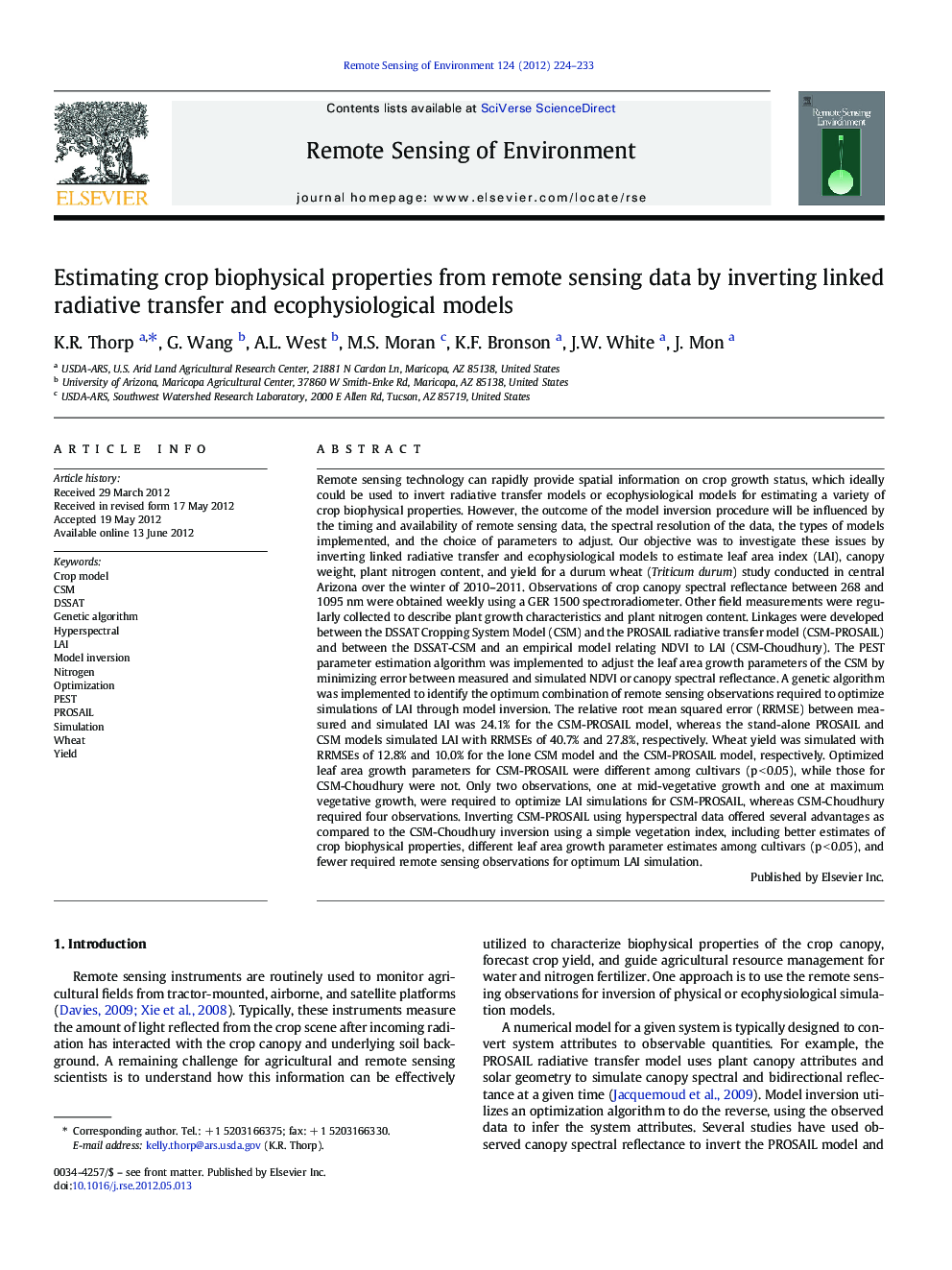| کد مقاله | کد نشریه | سال انتشار | مقاله انگلیسی | نسخه تمام متن |
|---|---|---|---|---|
| 4459001 | 1621276 | 2012 | 10 صفحه PDF | دانلود رایگان |

Remote sensing technology can rapidly provide spatial information on crop growth status, which ideally could be used to invert radiative transfer models or ecophysiological models for estimating a variety of crop biophysical properties. However, the outcome of the model inversion procedure will be influenced by the timing and availability of remote sensing data, the spectral resolution of the data, the types of models implemented, and the choice of parameters to adjust. Our objective was to investigate these issues by inverting linked radiative transfer and ecophysiological models to estimate leaf area index (LAI), canopy weight, plant nitrogen content, and yield for a durum wheat (Triticum durum) study conducted in central Arizona over the winter of 2010–2011. Observations of crop canopy spectral reflectance between 268 and 1095 nm were obtained weekly using a GER 1500 spectroradiometer. Other field measurements were regularly collected to describe plant growth characteristics and plant nitrogen content. Linkages were developed between the DSSAT Cropping System Model (CSM) and the PROSAIL radiative transfer model (CSM-PROSAIL) and between the DSSAT-CSM and an empirical model relating NDVI to LAI (CSM-Choudhury). The PEST parameter estimation algorithm was implemented to adjust the leaf area growth parameters of the CSM by minimizing error between measured and simulated NDVI or canopy spectral reflectance. A genetic algorithm was implemented to identify the optimum combination of remote sensing observations required to optimize simulations of LAI through model inversion. The relative root mean squared error (RRMSE) between measured and simulated LAI was 24.1% for the CSM-PROSAIL model, whereas the stand-alone PROSAIL and CSM models simulated LAI with RRMSEs of 40.7% and 27.8%, respectively. Wheat yield was simulated with RRMSEs of 12.8% and 10.0% for the lone CSM model and the CSM-PROSAIL model, respectively. Optimized leaf area growth parameters for CSM-PROSAIL were different among cultivars (p < 0.05), while those for CSM-Choudhury were not. Only two observations, one at mid-vegetative growth and one at maximum vegetative growth, were required to optimize LAI simulations for CSM-PROSAIL, whereas CSM-Choudhury required four observations. Inverting CSM-PROSAIL using hyperspectral data offered several advantages as compared to the CSM-Choudhury inversion using a simple vegetation index, including better estimates of crop biophysical properties, different leaf area growth parameter estimates among cultivars (p < 0.05), and fewer required remote sensing observations for optimum LAI simulation.
► We link PROSAIL and an empirical radiative transfer model with the DSSAT-CSM.
► We invert the models based on canopy spectral reflectance to estimate crop traits.
► The linked models estimated crop traits better than stand-alone model simulations.
► Model inversion using hyperspectral data had advantages over that based on NDVI.
► Only two remote sensing observations were required to optimize LAI for CSM-PROSAIL.
Journal: Remote Sensing of Environment - Volume 124, September 2012, Pages 224–233